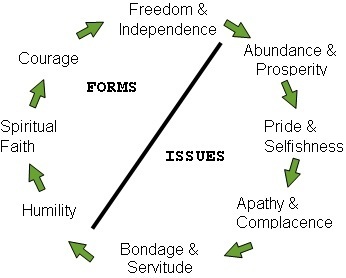By Kyle Roberts
 You can never change things by fighting the present reality. Instead, change the model that has created it, and the reality will change automatically.
You can never change things by fighting the present reality. Instead, change the model that has created it, and the reality will change automatically.
Another way to say this is you can never change things by haggling over issues and their complex nature.
Instead reexamine the form, or the structure, or the system that generated the issues, fix any defects or recommit to following proper procedure and the issues will dissolve automatically.
I was recently asked by some members of the Central Committee of my county’s Republican Party to teach them Robert’s Rules of Order.
The by-laws of the party were lately altered to make Robert’s Rules the standard rules of procedure for all meetings. Of course, most members of the Central Committee don’t know the rules and so are being railroaded into decisions and votes they disagree with.
Some members are fed up. They want a voice again but don’t know how to learn the rules.
I am not a member of the party, but I have associates and family who are. Through some connections I was asked to teach a class on Robert’s Rules to this committee.
The first class I had more than 70 slides prepared detailing the order of motions, how to make a motion, etc. We only made it through 10 slides.
I spent a majority of time fielding questions. Members would relate a scenario that happened in a certain meeting — most of which concerned actions of their Chair — wondering if it was valid and what they could do to stop it.
(I could fill volumes with the related cases of flagrant and willful violations of the rules. The intent of which, it was obvious to me, was to support the specific interests of the dominant powers within the Party. However, that is not the point of this article.)
One case involved the Chair arbitrarily suspending the rules and throwing out the orders of the day, (the previously-established agenda). The Chair then proceeded to make a series of executive decisions that violated the rights of members of the body and gave special privileges and recognition to those in the Party who, I learned later, were the chief forces that placed him in the position of Chair.
I also found out that the Chair was himself almost totally ignorant of Robert’s Rules, which inevitably led to him ruling by whim and frustration instead of by law.
Gotta love party politics.
Once I understood that 90 percent of their problems or issues stemmed from the Chair and the process of selecting the Chair I was able to resolve, in a fundamental way, all their concerns.
I simply told them they were focusing on the wrong thing.
Forms Versus Issues
They were trying to solve their problems by focusing on and directly attacking them. They should have focusing on their Form.
It’s the structure that is the problem. Fix the form and all these aggravating problems, or issues, will automatically dissolve.
Confused by this new concept of Forms versus Issues, they asked me to explain.
Laws can be broken down into various types, categories, and functions. Forms and Issues are simply one way of grouping different laws.
First, laws that deal with FORMS: These set up, grant powers, and control fundamental operations of any institution, including government. They are the frame, structure, or skeleton of the organization.
Second, laws that deal with ISSUES. These are also called policies, bureaucratic regulation, or most any law or rule created by an organization in addition to those that govern their form. “By-laws” are a good example. These are the flesh, decor, ornamentation, or appendages to the structure – or FORM.
A brief example is the difference between the law that governs the actual Constitutional process of the Electoral College and laws that would amount to the President’s current social agenda.
Unfortunately, when human beings approach a problem that needs solving we tend to concentrate on the issues first. Sometimes they become the beginning, middle, and end points as well.
Most know this approach tends to create more issues. Whether in a marriage, corporation, club, or government increasing the quantity of rules to solve a problem tends to generate additional problems and thus requires more rules.
Of course this is a slippery slope. Eventually it becomes “necessary” to make a rule which will ostensibly “solve” current or even potential issues of life in every particular. It gives rise to dictatorial governing.
Additionally, this slippery slope inevitably leads not towards, but away from the goal of overcoming issues.
It is similar to attempting to heal a sickly fruit tree by only examining the fruit and lopping off the bows that produced the sickly fruit, but never examining the trunk, root system, and soil. With each additional unenlightened prune comes an additional set of problems.
Once the forms are buried beneath piles of issues, forms are easily forgotten and altered.
The alteration, though, is not necessarily substantive — the words themselves are not changed. Rather, the alteration is done through implication. The meaning of the words change either through deliberate manipulation, ignorance, or both.
Begin Every Discussion of Decision-Making Process With the Forms in Mind
I explained to my class that the proper place to begin evaluation is in the FORMS. These should be checked on a regular basis for soundness, clarity, applicability, proper implementation, and potential inconveniences.
No man who has cows escape his pasture will first spend time looking the cows over, claim that one is too big, another too smart, while yet another is too small and dumb and conclude to sever all their hooves to ensure they no longer escape. Instead, he naturally will turn to his fence, find the weak point and mend it.
He also will regularly check his fence to ensure long-term soundness.
If the supporting structure is sound all else falls into place. I told my class they need to fix the form in their Constitution that governs the process of selecting their Chair. If that is structured in a way that secures the rights of the body and ensures the impartiality of the chair then most of their problems would go away — automatically.
America Must Shift Away From Debating Issues and Resurrect Forms
America must leave the issues to the winds and begin looking for and mending those FORMS that have been ignored, replaced, or altered.
The following cycle, known as the “Fatal Sequence,” details how free societies degenerate:

Along the path from Abundance to Bondage those laws tending to dominate the attention of society and which they spend most energy arguing over is ISSUES, or policy, the purpose of which has become to grant special power to special interests and regulate human action as efficiently as possible.
In contrast, from Humility to Freedom, of necessity, laws in the category of FORMS gain the spotlight, indeed the magnifying glass, and the complex irrelevant issues fall to the floor.
It is a necessity because those forms gave birth to freedom. If freedom is to be maintained then so to must those forms.
In 2010, it appeared that everyone is a constitutionalist. It is the current fashionable wind of doctrine and any conscious person who wants a chance knows they must respect it.
However, after a real examination of the talking points it is easy to see they are – for the most part – just a list of issues.
The few exceptions are term limits, balanced budget and holding congress to its trust obligations of not violating its enumerated powers of action. I don’t necessarily agree with all these, but they are the closest proposals to forms I have seen.
The media, newspapers, activists, and the people in general are mostly talking about issues. Examine them and see for yourself. Compare them against the difference between FORMS and ISSUES and see which group they fall into. Very few will be forms.
This is not to say they are not important to address. For any law that takes away freedom must be understood for what it is.
The process of repealing bad laws is done much faster and effectively by first changing or remembering the FORM that brought about the environment that produced the bad law(s).
However, the growing interest to understand the Constitution is a primary example of the beginning of the shift from ISSUES to FORMS. Many have realized the only way to part the curtains of complexity and technocracy is to go back to the original understanding of the Constitution.
The Constitution itself is an articulate, artistic, and masterful set of FORMS. Those forms established, set up, and maintain freedom. Despite all the violations the masterful structure of the Constitution has been and continues to be the leading roadblock to those who have and still do push for an empirical internationalist agenda.
It is still securing a large portion of the blessings of liberty to Americans because it is a good form.
If we want more of the blessings of liberty for ourselves and our posterity we have to stop directly fighting the present reality. We have to stop getting caught up in the distraction of issues.
Instead, if we want real change, real freedom, then we must go back to the model that has created it. Americans need to shift their focus and attention away from the distracting issues towards resurrecting the concrete forms that built the greatest and freest civilization the world has known.
By so doing, most of America’s issues will dissolve and our present regulated, bureaucratic reality will change automatically.
*******************************
 Kyle Roberts is a small business owner who has committed his life to the cause of freedom. He is dedicated to recreating strong local self-government in his community by creating, and helping others create, institutions that create and preserve freedom.
Kyle Roberts is a small business owner who has committed his life to the cause of freedom. He is dedicated to recreating strong local self-government in his community by creating, and helping others create, institutions that create and preserve freedom.
He teaches a four-part lecture series on the Original Understanding of the Constitution for free to the community.
Kyle and his wife Kim own and operate Prudent Living Food Storage. They live in Spanish Fork, Utah with their two children.






[…] checks and balances keep republics free and prosperous. Therefore, I am far more concerned with forms of government, rather than issues. For example, repealing the 16th and 17th amendments (forms) will do far more to restore our […]